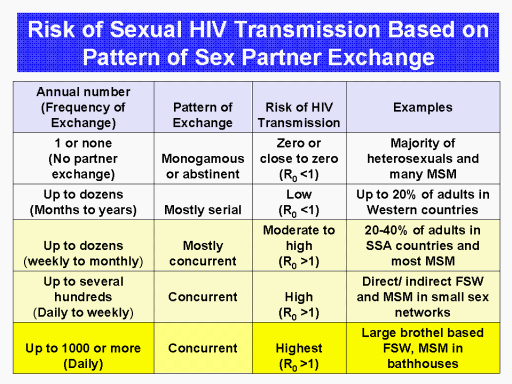| front |1 |2 |3 |4 |5 |6 |7 |8 |9 |10 |11 |12 |13 |14 |15 |16 |17 |18 |19 |20 |21 |22 |23 |24 |25 |26 |27 |28 |29 |30 |31 |32 |33 |review |
 |
Understanding the different patterns of epidemic
and nonepidemic sexual HIV transmission are of paramount importance
in understanding HIV transmission dynamics
Nonepidemic transmission pattern (R0
<1) occurs where there is: (1) no sex partner
exchange, or (2) only serial
sex partner exchange - when sex partner exchange is monthly or
annual (or even longer) with no concurrency of sex partners, no
epidemic HIV transmission can be expected.
Non-explosive epidemic pattern
(R0 >1
within several years) requires having sex with multiple and
concurrent sex partners within small sex networks (5-10 persons)
that overlap with each other.
This pattern is found in a large proportion
of MSM and 20-40% of
sexually active adults in many SSA populations.
Explosive
epidemic pattern (R0 >1
in less than a year) requires frequent, almost daily sex partner exchange
within large open sex networks. MSM
in bathhouse settings and FSW in large brothel type establishments are prime
examples of this pattern.
Not shown in this table is Transmission between HIV
discordant couples (R0 <1)
this occurs from an HIV infected person to his/her regular sex partner.
There is no further HIV spread if the regular sex partner does not have any
HIV risk behavior. Within HIV discordant couples, the annual risk of HIV
transmission can be up to 10% |